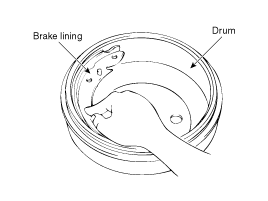| •
|
Frequent inhalation of brake pad dust, regardless of material
composition, could be hazardous to your health.
|
| •
|
Avoid breathing dust particles.
|
| •
|
Never use an air hose or brush to clean brake assemblies.
|
|
| •
|
Contaminated brake linings or drums reduce stopping ability.
|
| •
|
Block the front wheels before jacking up the rear of the
vehicle.
|
|
|
1. |
Raise the rear of the vehicle, and make sure it is securely supported.
|
|
2. |
Release the parking brake, and remove the rear brake drum.
|
|
3. |
Check the wheel cylinder (A) for leakage.

|
|
4. |
Check the brake linings (B) for cracking, glazing, wear, and contamination.
|
|
5. |
Measure the brake lining thickness (C).Measurement does not include
brake shoe thickness.
Brake lining thickness
Standard: 4.5 mm (0.177 in)
Service limit: 1.0 mm (0.039 in)
|
|
|
6. |
If the brake lining thickness is less than the service limit,
replace the brake shoes as a set.
|
|
7. |
Check the bearings in the hub unit for smooth operation. If it
requires servicing, replace it.
|
|
8. |
Measure the inside diameter of the brake drum with inside vernier
calipers.
Drum inside diameter
Standard: 203.2 mm (8.0 in)
Service limit: 205.2 mm (8.079 in)
Drum roundness
Service limit: 0.06 mm (0.00236 in)
|

|
|
9. |
If the inside diameter of the brake drum is more than the service
limit, replace the brake drum.
|
|
10. |
Check the brake drum for scoring, grooves, and cracks.
|
|
11. |
Inspect the brake lining and drum for proper contact.

|
|
12. |
Inspect the wheel cylinder outside for excessive wear and damage.
|
|
13. |
Inspect the backing plate for wear or damage.
|
•
Do not spill brake fluid on the vehicle: it may damage
the paint; if brake fluid does conta ...
 Hyundai Elantra MD/UD: Inspection
Hyundai Elantra MD/UD: Inspection




